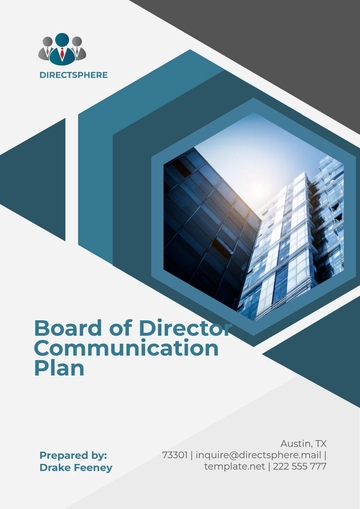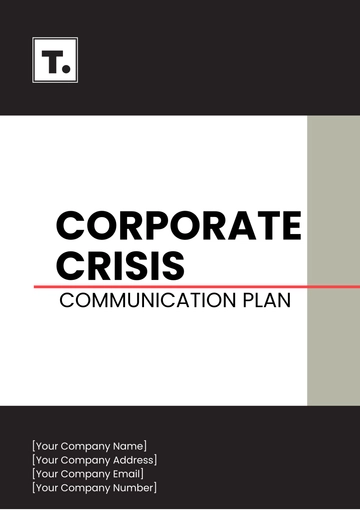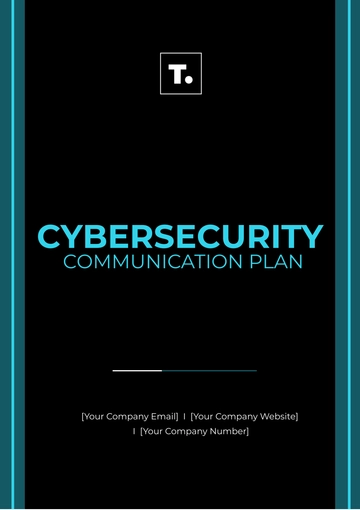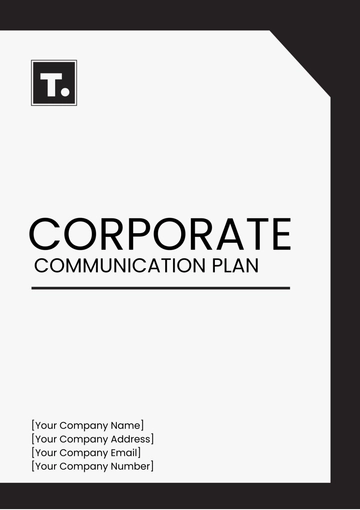Free Organizational Change Management Communication Plan

I. Introduction
A. Purpose
The purpose of this Organizational Change Management Communication Plan is to guide the communication efforts during the restructuring of [YOUR COMPANY NAME]. The objective is to ensure all stakeholders are informed, engaged, and supportive of the changes to minimize resistance and ensure a smooth transition.
B. Overview
[YOUR COMPANY NAME] is undergoing a significant restructuring to better align with our strategic goals and market demands. This restructuring will involve changes in organizational structure, roles, and responsibilities, aimed at enhancing efficiency, fostering innovation, and improving customer service. By communicating effectively throughout this process, we aim to ensure that all employees and stakeholders understand the rationale behind the restructuring and feel supported throughout the transition.
II. Communication Objectives
Provide Clear Information: Deliver clear, accurate, and timely information about the restructuring process, including its goals, timeline, and anticipated impacts. By providing transparent communication, we aim to reduce uncertainty and confusion among stakeholders.
Address Concerns: Proactively address concerns and questions from employees and other stakeholders to alleviate uncertainty and anxiety. By creating open channels for dialogue and feedback, we can address issues as they arise and build trust in the process.
Foster Positive Attitude: Foster a positive attitude towards the change by highlighting the benefits for the company, employees, and customers. By emphasizing the positive outcomes of the restructuring, we aim to generate enthusiasm and support for the changes ahead.
Ensure Understanding: Ensure all stakeholders understand the reasons behind the restructuring and the benefits it will bring to the organization. By clearly communicating the strategic objectives and desired outcomes of the restructuring, we aim to align everyone's efforts toward a common vision.
Maintain Productivity and Morale: Maintain productivity and morale during the transition period by providing support, resources, and opportunities for feedback. By offering support and encouragement to employees, we aim to minimize disruptions to daily operations and keep morale high throughout the restructuring process.
III. Key Messages
Reason for Change: [YOUR COMPANY NAME] is evolving to remain competitive and better serve our customers in a rapidly changing market. The restructuring is necessary to position the company for long-term success and growth.
Benefits: The restructuring will lead to streamlined processes, improved collaboration, and enhanced career development opportunities for employees. By aligning our organizational structure with our strategic goals, we can better leverage our resources and expertise to deliver value to our customers.
Support: We are committed to supporting our employees throughout the transition with training, resources, and open communication channels. By investing in our people and providing the support they need, we aim to ensure a smooth and successful transition for everyone involved.
Timeline: The restructuring process will be phased, with clear milestones and communication at each stage to keep everyone informed. By providing a detailed timeline, we aim to set realistic expectations and ensure that all stakeholders are aware of what to expect in the coming months.
Next Steps: Clear guidance will be provided on role changes, reporting structures, and support channels to ensure a smooth transition for all. By outlining the next steps and expectations, we aim to empower employees to navigate the changes confidently and effectively.
IV. Stakeholder Analysis
A. Primary Stakeholders
Employees: Directly impacted by the restructuring and essential for its success. Their understanding, support, and cooperation are critical for a smooth transition.
Managers and Supervisors: Responsible for communicating changes to their teams and providing support during the transition. Their leadership and guidance will be instrumental in maintaining morale and productivity.
Executives and Senior Leaders: Driving the strategic direction of the organization and overseeing the restructuring process. Their vision, support, and commitment are essential for the successful implementation of the changes.
Project Teams: Tasked with implementing specific changes and ensuring alignment with broader objectives. Their expertise and collaboration will be essential for executing the restructuring plan effectively.
B. Secondary Stakeholders
Customers: Will be affected by any changes in service delivery or product offerings resulting from the restructuring. Clear communication will be necessary to manage expectations and minimize disruptions to customer relationships.
Suppliers: Key partners who may need to adjust their relationships or processes in response to organizational changes. Open communication will be essential to ensure continued collaboration and mutual support.
Partners: Collaborators and stakeholders who may be impacted by changes in how [YOUR COMPANY NAME] operates or delivers value. Maintaining transparent communication will be crucial for preserving these relationships and fostering continued cooperation.
V. Communication Strategy
A. Communication Channels
Email: Weekly updates and FAQs sent via company email to ensure all employees receive consistent information. Email will serve as the primary channel for delivering timely updates and important announcements.
Intranet: A dedicated section on the company intranet for restructuring updates, resources, and discussion forums to encourage transparency and collaboration. The intranet will serve as a centralized hub for accessing information and engaging in dialogue about the restructuring process.
Town Hall Meetings: Monthly virtual town hall meetings with live Q&A sessions to provide updates, address concerns, and foster a sense of community. Town hall meetings will offer employees the opportunity to ask questions, share feedback, and connect with leadership in real time.
Department Meetings: Bi-weekly department meetings for detailed updates and feedback sessions, allowing for tailored communication based on specific team needs. Department meetings will provide a forum for discussing how the restructuring will impact individual teams and addressing any concerns or questions.
Newsletters: Bi-monthly newsletters with success stories, employee spotlights, and restructuring updates to celebrate progress and maintain engagement. Newsletters will help keep employees informed about the latest developments and recognize their contributions to the company's success.
Social Media: LinkedIn and Twitter updates to share progress, celebrate milestones, and showcase [YOUR COMPANY NAME]'s commitment to positive change. Social media will be used to amplify key messages and engage with external stakeholders, such as customers, partners, and industry influencers.
B. Frequency
Weekly Updates: Email and intranet postings to keep employees informed of progress and upcoming milestones. Weekly updates will provide regular updates on the status of the restructuring and address any emerging issues or concerns.
Monthly Town Halls: Virtual meetings with live Q&A to provide a forum for open dialogue and address emerging issues. Monthly town hall meetings will offer employees the opportunity to engage directly with leadership and share their feedback and ideas.
Bi-monthly Newsletters: Distributed via email to provide a more in-depth look at key developments and highlight employee achievements. Bi-monthly newsletters will showcase the positive impact of the restructuring and celebrate the accomplishments of individual employees and teams.
VI. Roles and Responsibilities
Role | Responsibilities |
|---|---|
Change Management Team | Lead the development and execution of the communication plan, ensuring alignment with objectives. |
Project Managers | Collaborate with the Change Management Team to ensure communication efforts align with milestones. |
HR Department | Provide support to employees, address concerns, and facilitate communication between leadership. |
Communications Department | Craft and disseminate messages across channels, ensuring consistency with organizational messaging. |
VII. Communication Timeline
Date | Activity | Description |
|---|---|---|
March 1, 2050 | Initial Announcement | Company-wide email and town hall meeting to announce the restructuring, its goals, and anticipated timeline. |
March 15, 2050 | Department Meetings | Detailed meetings with each department to discuss specific impacts, answer questions, and gather feedback. |
April 1, 2050 | Follow-up Communication | Email updates and intranet posts providing progress updates and outlining the next steps in the restructuring process. |
May 1, 2050 | Progress Review | Town hall meeting to review progress, address ongoing concerns, and provide updates on key milestones achieved. |
June 1, 2050 | Final Adjustments | Final communication on the completion of the restructuring phase, including any remaining actions and next steps for moving forward. |
VIII. Feedback and Evaluation
A. Feedback Mechanisms
Surveys: Monthly employee surveys to gauge sentiment, collect feedback, and identify areas for improvement.
Focus Groups: Quarterly focus group sessions with representatives from different departments to delve deeper into specific issues and concerns.
Direct Feedback: Open channels for direct feedback via email, suggestion boxes, or dedicated communication forums to encourage transparency and participation.
B. Evaluation
Success Metrics: Employee engagement scores, productivity levels, and overall sentiment are measured through regular surveys and performance indicators.
Review Meetings: Quarterly review meetings with key stakeholders to assess the effectiveness of the communication plan, identify lessons learned, and make necessary adjustments to ensure continued alignment with organizational goals.
IX. Conclusion
Effective communication is paramount to the success of [YOUR COMPANY NAME]'s organizational restructuring. By implementing the strategies outlined in this plan, we ensure stakeholders are informed, engaged, and supportive. Regular evaluation will enable us to adapt and ensure alignment with our objectives. Together, we will emerge stronger and better positioned for future success.
- 100% Customizable, free editor
- Access 1 Million+ Templates, photo’s & graphics
- Download or share as a template
- Click and replace photos, graphics, text, backgrounds
- Resize, crop, AI write & more
- Access advanced editor
Boost your organizational change efforts with Template.net's Organizational Change Management Communication Plan Template. This fully customizable and editable template is designed to ensure smooth transitions and clear communication within your team. Enhance efficiency with our intuitive AI Editor Tool, making it easy to tailor the plan to your specific needs.





























